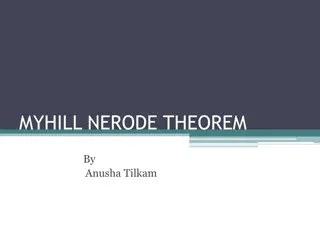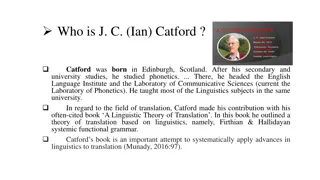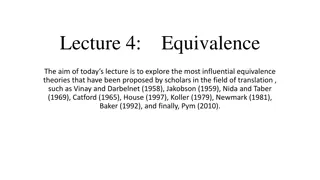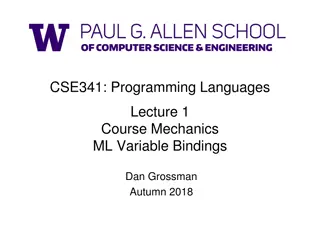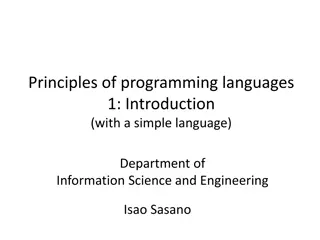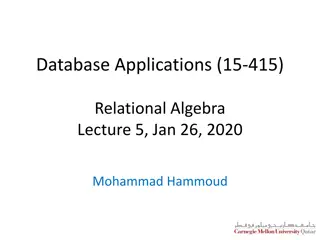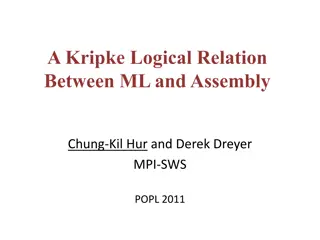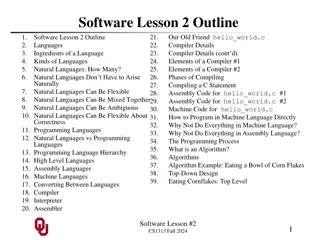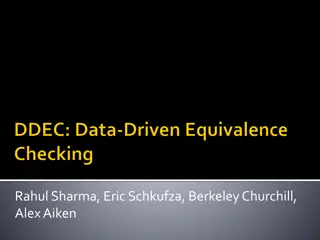Understanding Equivalence in Programming Languages: CSE341 Lecture Summary
In CSE341's Programming Languages lecture, Equivalence is explored as the fundamental software engineering concept of determining if two pieces of code are equivalent. The focus is on code maintenance, backward compatibility, optimization, and abstraction. Equivalence is defined by having the same observable behavior, producing equivalent results, and more, with examples given to illustrate the concept. The importance of avoiding side effects and using pure functions for equivalence is emphasized.
Download Presentation

Please find below an Image/Link to download the presentation.
The content on the website is provided AS IS for your information and personal use only. It may not be sold, licensed, or shared on other websites without obtaining consent from the author. Download presentation by click this link. If you encounter any issues during the download, it is possible that the publisher has removed the file from their server.
E N D
Presentation Transcript
CSE341: Programming Languages Lecture 12 Equivalence Dan Grossman Spring 2019
Last Topic of Unit More careful look at what two pieces of code are equivalent means Fundamental software-engineering idea Made easier with Abstraction (hiding things) Fewer side effects Not about any new ways to code something up Spring 2019 CSE341: Programming Languages 2
Equivalence Must reason about are these equivalent all the time The more precisely you think about it the better Code maintenance: Can I simplify this code? Backward compatibility: Can I add new features without changing how any old features work? Optimization: Can I make this code faster? Abstraction: Can an external client tell I made this change? To focus discussion: When can we say two functions are equivalent, even without looking at all calls to them? May not know all the calls (e.g., we are editing a library) Spring 2019 CSE341: Programming Languages 3
A definition Two functions are equivalent if they have the same observable behavior no matter how they are used anywhere in any program Given equivalent arguments, they: Produce equivalent results Have the same (non-)termination behavior Mutate (non-local) memory in the same way Do the same input/output Raise the same exceptions Notice it is much easier to be equivalent if: There are fewer possible arguments, e.g., with a type system and abstraction We avoid side-effects: mutation, input/output, and exceptions Spring 2019 CSE341: Programming Languages 4
Example Since looking up variables in ML has no side effects, these two functions are equivalent: val y = 2 fun f x = y * x fun f x = x + x But these next two are not equivalent in general: it depends on what is passed for f Are equivalent if argument for f has no side-effects val y = 2 fun g (f,x) = y * (f x) fun g (f,x) = (f x) + (f x) Example: g ((fn i => print "hi" ; i), 7) Great reason for pure functional programming Spring 2019 CSE341: Programming Languages 5
Another example These are equivalent onlyif functions bound to g and h do not raise exceptions or have side effects (printing, updating state, etc.) Again: pure functions make more things equivalent fun f x = let val y = g x val z = h x in (y,z) end fun f x = let val z = h x val y = g x in (y,z) end Example: g divides by 0 and h mutates a top-level reference Example: g writes to a reference that h reads from Spring 2019 CSE341: Programming Languages 6
One that really matters Once again, turning the left into the right is great but only if the functions are pure: map f (map g xs) map (f o g) xs Spring 2019 CSE341: Programming Languages 7
Syntactic sugar Using or not using syntactic sugar is always equivalent By definition, else not syntactic sugar Example: fun f x = if x then g x else false fun f x = x andalso g x But be careful about evaluation order fun f x = if g x then x else false fun f x = x andalso g x Spring 2019 CSE341: Programming Languages 8
Standard equivalences Three general equivalences that always work for functions In any (?) decent language 1. Consistently rename bound variables and uses val y = 14 fun f x = x+y+x val y = 14 fun f z = z+y+z But notice you can t use a variable name already used in the function body to refer to something else val y = 14 fun f x = x+y+x val y = 14 fun f y = y+y+y fun f x = let val y = 3 in x+y end fun f y = let val y = 3 in y+y end Spring 2019 CSE341: Programming Languages 9
Standard equivalences Three general equivalences that always work for functions In (any?) decent language 2. Use a helper function or do not val y = 14 fun g z = (z+y+z)+z val y = 14 fun f x = x+y+x fun g z = (f z)+z But notice you need to be careful about environments val y = 14 fun f x = x+y+x val y = 7 fun g z = (f z)+z val y = 14 val y = 7 fun g z = (z+y+z)+z Spring 2019 CSE341: Programming Languages 10
Standard equivalences Three general equivalences that always work for functions In (any?) decent language 3. Unnecessary function wrapping fun f x = x+x fun g y = f y fun f x = x+x val g = f But notice that if you compute the function to call and that computation has side-effects, you have to be careful fun f x = x+x fun h () = (print "hi"; f) fun g y = (h()) y fun f x = x+x fun h () = (print "hi"; f) val g = (h()) Spring 2019 CSE341: Programming Languages 11
One more If we ignore types, then ML let-bindings can be syntactic sugar for calling an anonymous function: let val x = e1 in e2 end (fn x => e2) e1 These both evaluate e1 to v1, then evaluate e2 in an environment extended to map x to v1 So exactly the same evaluation of expressions and result But in ML, there is a type-system difference: x on the left can have a polymorphic type, but not on the right Can always go from right to left If x need not be polymorphic, can go from left to right Spring 2019 CSE341: Programming Languages 12
What about performance? According to our definition of equivalence, these two functions are equivalent, but we learned one is awful (Actually we studied this before pattern-matching) fun max xs = case xs of [] => raise Empty | x::[] => x | x::xs => if x > max xs then x else max xs fun max xs = case xs of [] => raise Empty | x::[] => x | x::xs => let val y = max xs in if x > y then x else y end Spring 2019 CSE341: Programming Languages 13
Different definitions for different jobs PL Equivalence (341): given same inputs, same outputs and effects Good: Lets us replace bad max with good max Bad: Ignores performance in the extreme Asymptotic equivalence (332): Ignore constant factors Good: Focus on the algorithm and efficiency for large inputs Bad: Ignores four times faster Systems equivalence (333): Account for constant overheads, performance tune Good: Faster means different and better Bad: Beware overtuning on wrong (e.g., small) inputs; definition does not let you swap in a different algorithm Claim: Computer scientists implicitly (?) use all three every (?) day Spring 2019 CSE341: Programming Languages 14



